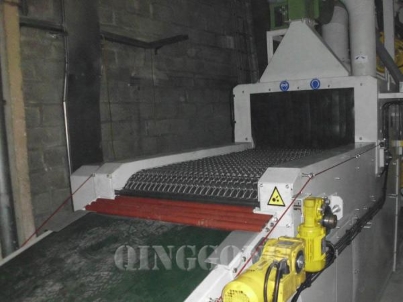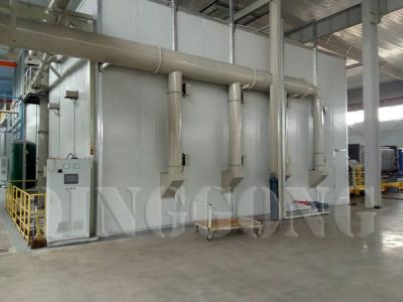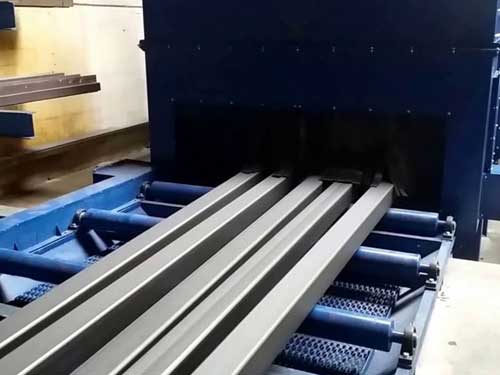The quality of thermal spraying is closely related to the pretreatment process of thermal spraying. If the pretreatment is good, the quality of thermal spraying will be guaranteed, while if the pretreatment process is not dealt with well, the quality of thermal spraying must be poor. In view of this, this paper focuses on the pretreatment process of thermal spraying and the sandblasting process and makes a detailed description.
Technique Analysis of Thermal Spraying Process and Sandblasting Process
The purpose of surface roughening by sandblasting before thermal spraying
The sandblasting pretreatment of the matrix surface is to use high-speed abrasive particles with high hardness to spray the matrix surface and produce scouring, chiseling and hammering effects on the surface, so as to remove the rust, scale, burr, welding slag, old ceramic coating and other dirt from the matrix surface, and form the matrix surface with considerable roughness, which can make the metal matrix expose its fresh active surface, and at the same time produce purification, coarsening and activation effects. In addition, sandblasting can relax the stress of the matrix material and improve its fatigue strength. Besides, sandblasting has high production efficiency, so it is particularly suitable for surface pretreatment and field construction of large-scale and mass production products, which makes it become the most commonly used surface pretreatment method in industry.
What are the requirements of thermal spraying for the surface roughness of sandblasting
In order to obtain satisfactory coating bonding strength, thermal spraying has specific requirements on the roughness of the matrix surface after sandblasting.
1. The surface roughness (Ra, i.e. the arithmetic mean value of wave crest and trough of sandblasted surface) is used to represent the appropriate surface roughness value of thermal spraying under different conditions.
Generally, the bonding strength of the coating increases with the increase of surface roughness. However, when Ra is more than 10μm, the effect is greatly weakened. In order to obtain the best bonding strength of the coating, the corresponding surface roughness dimension should be 3/4 of the diameter of the sprayed powder.
2. It is expressed by the morphology of the sandblasting surface
According to the standard of GB8923-88 The Corrosion Grade and Derusting Grade of Steel Surface before Coating, the sandblasting derusting classification of steel materials during thermal spraying shall reach the highest Sa 3.0 level, that is, the metal matrix looks white, and the surface after sandblasting is free of obvious oil, grease, dust, mill scale, rust spot, coating film, oxide, corrosion products and other foreign substances. It should at least reach secondary Sa 2.5 level, which is close to white. The morphology and color of the matrix surface after sandblasting shall be compared with the standard grade picture or standard grade template of steel surface sandblasting.
The change of sandblasting gas pressure has the greatest impact on the internal stress of the matrix surface. Sandblasting with high-pressure gas on the surface of thin plates and long pieces often leads to distortion and deformation of the workpiece, and the surface of soft matrix (such as aluminum, zinc, babbitt metal, etc.) will be inlaid with sandblasted abrasives. In addition, with the increase of sandblasting gas pressure, the surface activity of the matrix is enhanced, the surface roughness value is increased, and the sandblasting efficiency is improved. For steel, stainless steel and alloy steel workpieces, the gas pressure value shall be equal or greater than 0.5MPa, and for soft matrix workpieces, the gas pressure value should be less than or equal to 0.3MPa.
The variation of sandblasting distance has the greatest influence on sandblasting efficiency, followed by the surface roughness of the matrix. Generally, the hardness of the matrix surface is greater than 45 HRC, the sandblasting distance is 100 mm-150 mm; if the matrix surface hardness is between 25 HRC and 45 HRC, the sandblasting distance is 150 mm - 200 mm; the surface hardness of soft matrix is less than 150 HB, and the sandblasting distance is 250 mm - 300 mm.
The change of sandblasting angles mainly influences the roughness of the matrix surface. When the sandblasting angle changes from 30° to 75°, the roughness increases with the increase of the angle, but the best sandblasting angle is 70° - 80°.
The change of sandblasting time has a great influence on the surface activation degree of the matrix. Generally, the surface activity increases with the increase of the fixed sandblasting time for the workpiece, but when the sandblasting time reaches about 20s, the surface activity basically reaches saturation. Generally, when the surface roughness of the matrix reaches Sa3, the sandblasting time is about 5S-10s.
How to choose the morphology of sandblasting abrasives
The sandblasting abrasives must be clean, dry and with edges and corners. It is forbidden to use the abrasives which are used after casting shot blasting to carry out the sandblasting pretreatment of thermal spraying. In the process of sandblasting, the abrasive will be crushed to different extent according to its type and performance. Fine dust will not only affect the sandblasting efficiency, but also deposit on the pretreated surface of the matrix, which will influence the bonding of spray coating and pollute the environment. Therefore, when the pulverization of abrasive is more than 20%, the micro powder should be sieved, and the abrasive should be cleaned and dried before reuse. It is better to adopt 50% recycled abrasives + 50% new abrasives for reuse.
The principle of injector sandblasting machine
Injector sandblasting machine (also known as suction sandblasting machine) is a device that uses the negative pressure caused by compressed airflow in the injection and suction chamber of the sandblasting gun to inhale sand particles through the sand pipe and spray them out from the nozzle with the airflow to roughen the surface of the workpiece. This sandblasting method is simple in equipment and easy to use, but it has less sand suction, lower spraying speed and lower sand blasting efficiency, so it is usually used for sandblasting of small area or thin wall parts and non-ferrous metals. The structural diagram of the injector sandblasting machine is shown in the figure. In the process of sandblasting, the high-speed airflow from the air nozzle forms a negative pressure around, and the abrasive is sucked in from the conical hopper at the bottom of the sandblasting box through the sand suction pipe and brought into the high-speed jet airflow. In the high-speed airflow, the abrasives are accelerated and sprayed to the surface of the workpiece matrix. In a closed sandblasting cabinet, the sand impacting on the surface of the workpiece is ejected and collected in the sandblasting cabinet, then it drops into the funnel through the screen for recycling. Abrasives can be used continuously until they are crushed and lose the sandblasting effect. There are small manual operation devices and medium-sized, fully automatic system devices in injector sandblasting machines. This kind of sandblasting machine is suitable for the non-metallic abrasives with low relative density, but not suitable for metal abrasives with higher relative density because the relative density is higher, and the cast iron sand or steel sand with larger particle size needs more negative pressure suction force.
Compared with pressure sandblasting machine and centrifugal sandblasting machine, the production efficiency of injector sandblasting gun is lower and the sand suction pipeline is shorter, so it is only suitable for processing small volume workpieces. However, this kind of sandblasting gun has the advantages of simple structure, low price, flexible use and convenient maintenance, and it can be used for local sandblasting in small area on site. The injector sandblasting gun needs less compressed airflow but higher pressure, which is usually 0.52Mpa - 0.7MPa.
 EN
EN
 fr
fr  de
de  es
es  it
it  ru
ru  pt
pt  ar
ar  th
th  pl
pl  ro
ro 


